CLICK ON IMAGES TO ENLARGE. REPEAT IF REQUIRED.
For once I have not featured my archive material on a rainy day post, for I had yesterday’s images from Margery’s exhibition that I had not had time to upload last night.
As will be seen from this front page of the promotional leaflet, ‘Hanging Around’ is a prelude to an important exhibition next spring.
I featured a photographic portrait of the artist in ‘Hanging Around Part 1’. The leaflet contains a pen picture.
Here are visiting details for those fortunate enough to be within striking distance.
With work going on around me, I photographed a few of the works at random.
It is only three or four years ago that my sister, Liz Keenan, taught Margery to create handmade books, and she has brought her own stamp to them.
The wonkiness of these images is nothing to do with the hangers, but is all the responsibility of the photographer. Since the pictures had mostly not yet been labelled, I cannot give the titles, but most tell their own story. Margery’s sensitivity shines out of this one that leaves the viewer to supply the subject’s thoughts, which will probably reflect their own.
The Cyclist appears in one of the artist’s small rectangular formats, and amply displays her renowned humour.
We smile with Margery at these two friends staggering home from their hostelry.
Clarke is equally at home with a large scene, making full use of its space.
The year before Margery painted these dancing nuns in 1964, the Belgian Dominican Sister Luc Gabriel, known to us as the Singing Nun, recorded this hit:
[youtube https://www.youtube.com/watch?v=n295hjktHD0&w=560&h=315]
Was our friend influenced by this, I wonder? (See Paul’s comment below; and his longer one describing the influences of other pictures)
Even garbage collectors are represented with a sense of fun. How is he going to pick up his lid?
High Steps appears in the leaflet;
as does Pub Interior, displaying the artist’s innate sense of composition and perspective.
It looks as if a joyful greeting is taking place here.
Margery is also capable of dramatic landscapes;
and grand scenes like Assembling In The Square.
She enjoys musical themes
and a chuckle is never far away.
This evening we dined on Jackie’s excellent chilli con carne with rice and peas, followed by lemon meringue pie ice cream. We both drank sparkling water.


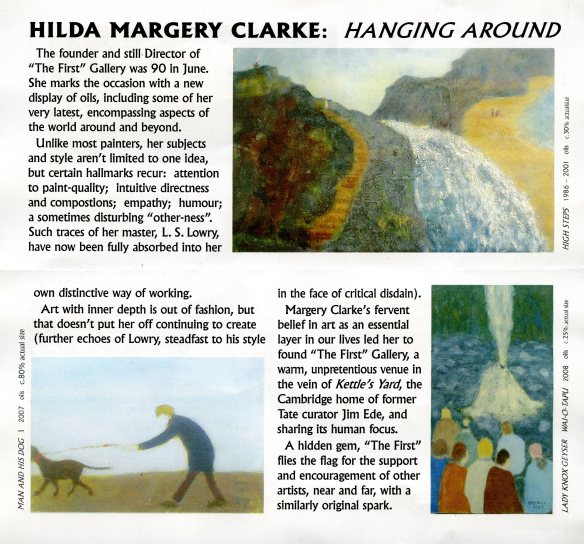
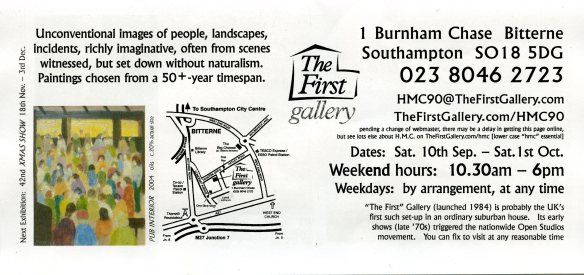






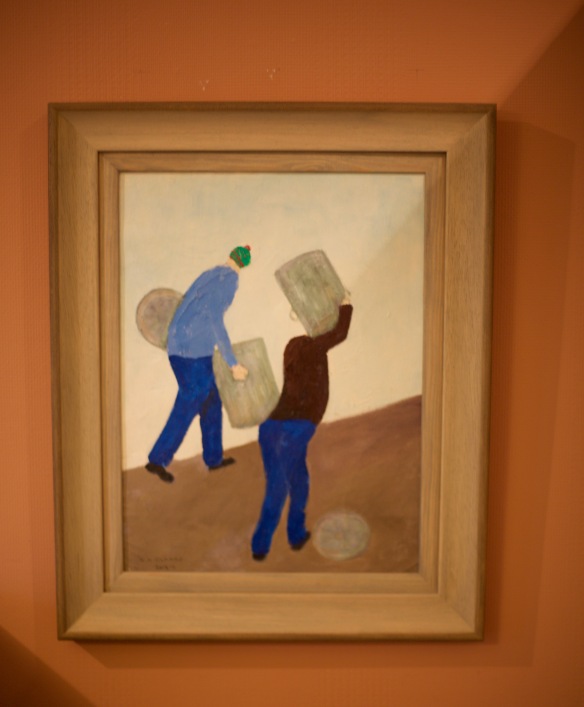



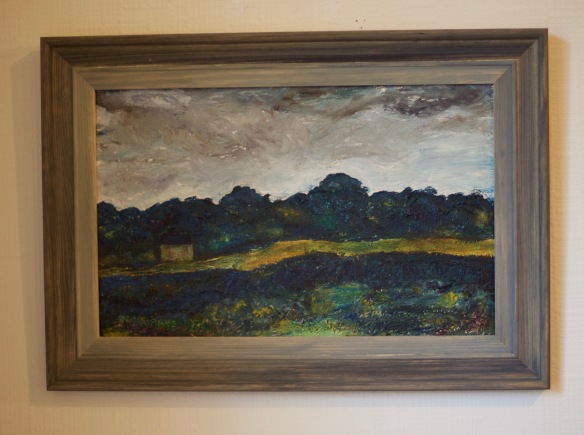
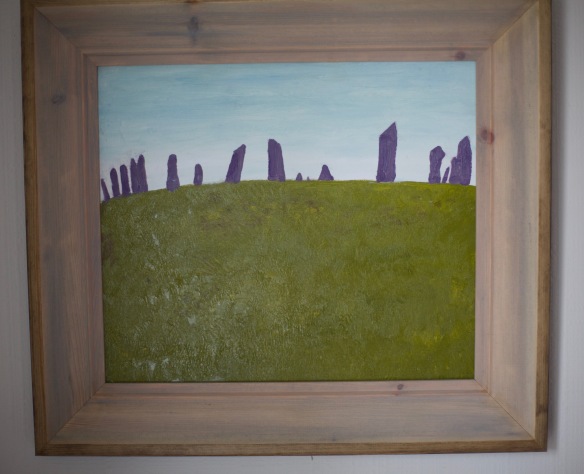



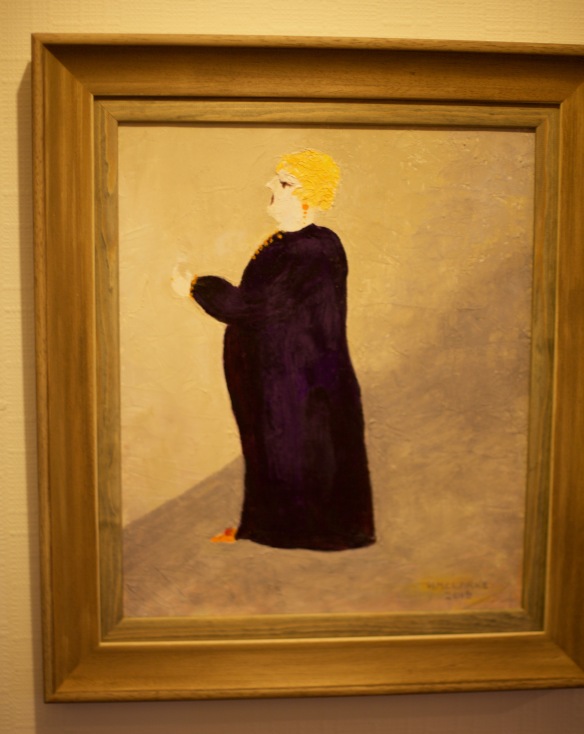
Lovely paintings with a strong personality behind them, it’s plain to see. The handmade books are beautiful as well.
Many thanks, Oglach
Those are wonderful. Fun to examine, too–especially the last one ;).
Thanks very much, Luanne
All those paintings are full of humour. 🙂 Your evening meal sounds delicious.
Many thanks, Sylvia
Thanks for sharing these Derrick! Hope you have been well!
Thanks, Jarrod. I am OK.
The “Dancing Nuns” have a curious genesis, unrelated to Soeur Sourire (rpesumably a stage-name?) In the days when nuns mostly walked everywhere, and wore full-length habits, Margery used to see them so often she almost wondered if they were following her about. At the time, her sister was ahvng a nervous breakdown, so she was probably recalling a higher proportion than the actuality. She did quite a few paintings of them, nearly all back-views, so just silhouettes (which have a sinister overtone as well as their straightforward pictorial element). She remarked to an artist friend that she was painting nothing but nuns, and he replied: “Don’t worry, there’ll come a time when you can’t paint one to save your life”. (In that context, “paint” meant creating an image with the intensity that these current ones were achieving. He was right: years later, she tried to consciously do another, as if to test the theory, and the inspiration didn’t flow, as it had inexplicably done before).
Soon after the initial phase of nun images stopped, she heard one interviewed on the radio, who was asked what she missed most from her previous life. “Dancing”, she replied.
About a year after that (perhaps 1965) another artist friend saw the painting and remarked “Ah! Matisse!”. Margery had never seen Matisse’s “La Danse”, neither for real, nor in reproduction.
Significantly, the first artist friend had worked on one theme most of his artistic life, then changed because he felt he had “worked through it”; the second one, though never formally a student, was learning his technique by observing and absorbing the works of the great Masters (as most artists are trained to do). So, both applied their own experiences, even though Margery didn’t and doesn’t operate to either of those patterns.
Thanks very much, Paul, for this important addition. Of course I didn’t think Margery was thinking about the Singing Nun, but I couldn’t resist the link.
Well, it IS the right period!
The image of the nuns is one of my favorites, as nuns were omnipresent in my formative years.
I also do see something like Matisse in the paintings, though I would never consider them derivative. Actually, I love best the sense of humour in many of these….especially the last one. As some wit quipped–and is nearly a proverb by now—“It ain’t over until the fat lady sings.”
And speaking of singing, I loved hearing The Singing Nuns again after all these years, Derrick. I shall be going about the house singing it all evening…domi-nique, nique, nique…s’en allait tout simplement., routier, pauvre et charmant….
Best wishes to Margery as she opens this wonderful exhibit.
As I was UNfamiliar with this piece, I appreciated your karaoke aid (btw, the last word sounds like “chantant” on the recording. Not sure if this is dodgy recall, a mistake in your early years learning, or one of those annoying WordPress auto-corrects!)
Thanks.
Of course you are right….I always sang it as “chantant” but my auto- correct thought better of it. (Perhaps it thinks St. Dominic was as charming as he was musical.) Could I have extra credit for working hard to get my laptop to say “humour” in my comment, instead of “humor?”
Extra credit willingly granted 🙂
I’ll pass on to Margery your (and others here) good wishes. Many thanks.
Very lovely comments, Cynthia. Thank you. Once again, you provide something I wish I’d thought of -‘It ain’t over…….’
What a wonderful exhibit. I love her landscapes. Thanks for sharing, Derrick!
Many thanks, Jill
Thanks for sharing this with us!
Thank you, Lynn
Lovely paintings with a distinctive style Derrick, thank you for sharing them with us.. 🙂
Thank you, Sue
Reblogged this on Life is But This and commented:
I have at least three calligraphy students older than me, each of them talented and artistic. I have been encouraging one of them to exhibit her oil paintings (she is self taught) but she is reluctant as she has been doing it for her own enjoyment only. One day she brought in a few pieces to share with the class and we were staggered by the quality of her work. I am reblogging this post by Derrick to motivate her 🙂
Good for you: let’s hope it works
Thank you, Paul. I hope so too.
Thank you for filling in the background information. I have been admiring the painting and wondering about the stories behind them.
Me, too, Mary. And Paul responded beautifully to this prompt
Thank you, Mary. Well done
At risk of over-filling the comments with my text, here are the titles, in order of posting, with explanation of some of them. Much of HMC’s imagery is derived from glimpses of something in the real world, but much changed by the time the painting is finished:
Man Eating Crisps — seen in a nearby, run-down suburb in 1960s (roughly same age as Dancing Nuns). In about 2012, she added the cityscape background and colour to parts of his attire. [Those of you abroad may be unfamiliar with the flat cap, an item of apparel linked in the public eye with the working classes. Because he has his head down, you’re viewing it from the top]
Cyclist — actually seen, but perhaps not with such ‘flying’ clothing. I believe the gap looked too narrow in the actual sighting
Two Drunks — entirely imaginary [readers will be glad to know it’s not based on Derrick and the Head Gardener]
Corridor — though crowds are a ‘theme’ of hers, this is from imagination, but inspired by the news announcement of the creation of Refugee Corridors in one of the recent wars (the Balkans, I think)
Dancing Nuns — described above
Dustmen — seen in the street. She was intrigued by the balletic movement as they hoist the containers on to their shoulders, a sight no longer witnessed here with the advent of wheelie-bins. (I’m not sure if the ‘problem’ of the lid was the point, here. It may be that to minimize the weight carried, binmen left the lids on the ground while taking them to the truck)
High Steps — entirely imaginary. The ‘impossible’ topography took a long time to resolve; I think the waterfall was added to make visual sense of the two slightly separate landscapes. In case it’s not clear as you enlarge the image, the Steps are the snaking ochre line on the left-hand bluff. Tiny retreating figures are another recurrent motif
Pub Interior — not Margery’s habitual environment! We’d been to mid-Wales to see a friend appearing in her village’s amateur dramatic play, and this was the impression of the joyous gathering in the beamy-ceilinged pub afterwards
Greeting — entirely imaginary, including the landscape (the pole on the left is there for compositional reasons)
Landscape with Cottage — quite an old one (1970), and MAY be based on a childhood visit to the shores of Loch Fyne in western Scotland (if so, the visit wasn’t very happy: she wanted to avoid staying there overnight on our recent trip to Scotland), but probably partly imaginary, too. Her palette has changed markedly since this period
Ring of Brodgar, Orkney — one of the most famous megalithic sites on this once major travel-hub, images of it are regularly appropriated by local producers ‘branding’ their goods as Orkney-made. The stone circle is on the top of a low hill, and the current approaches to it are all from below: this captures that effect very well. If you think they look a bit like ‘Margery Clarke’ figures, that’s an accident that Margery would probably not discourage. While we were there, I speculated that maybe one reason the circles look like this is because they resemble a mass of spectators and, to groups of early people unable to communciate at a huge distance (e.g. out of sight of each other), this illusion of a crowd gathering might encourage more of them to attend. This website might provide more history, and some photographs http://www.historicenvironment.scot/visit-a-place/places/ring-of-brodgar-stone-circle-and-henge/
Orkney is the nearer of the two island groups off the north coast of Scotland
Matterhorn — Europe’s most identifiable mountain, and familiar to Margery from many travel-book images, In 1990, she passed by it, triggering this painting. Because she rarely uses photographic reminders, it was done from her recall of the sight of the peak glistening in the sun
Assembling in the Square — the square is based on Albert Square, in the centre of her native Manchester, in the north-west of England, with the soot-blackened (as it was, until a fairly recent clean-up) Town Hall in the background. The event is non-specific and the attenders imaginary, but is a distillation of the Whit Walks, banner-led processions by religious groups and other social enterprises at Whitsuntide (late May) which brought the city to a standstil in their heyday. She and her sister used to participate in them as children (banners were another early recurrent theme)
Massed Saxophones — an attempt at our city University (Southampton, UK) to break the world record for the most saxophones playing together. I’m not sure what the record-breaking number would have been, but I don’t think this picture echoes the full extent of the attendance (which didn’t achieve its aim). Quite different from the actual setting, but the uprights obstructing the sightlines were actually there. Artistically (and especially in “academically-correct Art” terms), these are a nuisance and, as an imaginative painter, she could have left them out. However, setting herself a visual challenge and then solving it is a problem she relishes (good for the creative soul, perhaps?), so they stayed in!
Aspiration — the clue’s in the title. A subtle self-portrait: not that Margery sings, but she’s aware that she (and most people) don’t achieve all they dream of doing or being, and this lady isn’t going to reach her top note, is she?
I’ve filled these in because Margery, although she keeps up with this blog, is a little… how shall we say?, behind the curve on things technological and doesn’t know about the comments section, or about being able to contribute to them.
Very many thanks, Paul. I have added notes in the text to alert people to this and the Dancing Nuns comment. Really useful
Cynthia J: afraid we’ve over-filled that thread and there’s no direct Reply button there, so am replying way distant from your original comment. You’re definitely granted brownie points for the ‘correct’ 🙂 spelling and I’m especially glad you mentioned it, because, as a native Englishman, I hadn’t noticed!! “Favorite” did momentarily alert the proof-reader manqué in me, though, but I’ve learned not to fret over things you can’t change (e.g. typos in WordPress postings… )
I love these paintings
Thank you, Sylvie
These are great. I love the bicyclist and the landscape with cottage. I also like the small book that appears to have a turtle on the cover. This would be a very fun show to visit.
Many thanks, Lisa
Lisa, if you’re meaning the book titled “Shambli”, it’s a sheep and the fleece is actually knitted. Yes, all a bit surreal, and so is the story.
I need to enlarge the picture! Regardless, It caught my eye. I liked the idea of small handmade books…
I was interested to read in the leaflet that Margery’s style was influenced by Lowry. Her paintings are distinctively her own, of course, but I can certainly see some influence there. I think her work has a refreshing whimsy about it too.
Thank you, Bun. Whimsy is a good word
I’m very tempted to take a trip down to Bitterne, Derrick. It’s not far from where family used to live so I’m familiar with the territory…
Let us know if you do, Jenny. Thank you.
You’d be realy welcome. Depending on how long since you’ve been, you might not recognize Bitterne, much demolished for a bypass about 35 years ago!
Lovely paintings, Derrick! Thank you so much for sharing them with us!
Thank you, Sofia
Margery is a wonderful and diverse artist. She certainly has talent and shows a wide range of scenes in her paintings. You created a fine composition in your pamphlet/flyer, Derrick.
The steps up along the mountain stream or river was my favorite painting, “High Steps.”
Many thanks Robin. Actually, the flyer was all Paul’s work 🙂
I didn’t like to mention that. Modesty forbids, but thanks, Robin.
🙂 I did think, momentarily about taking the credit, but then I would probably have gone to Hell (in a hand cart, says Jackie)
I enjoyed this post with Margery’s work very much, Derrick. Thank you for sharing.
Also, thanks to Paul for the explanations. It’s interesting, but I didn’t realize the dancing women were nuns at first. 🙂
Many thanks, Merril
A great post featuring Margery’s work, Derrick. Her works are of myriad tastes depicting different things from the society. The “Dancing Nuns” is surely a wonderful one. Thanks to Paul Clarke for the explanatory note… 🙂
Thanks, Maniparna
Welcome… 🙂
Thank you, Maniparna
This was a visit at an exhibition. I liked the pictures.
Many thanks, Micheline
Margery’s talent and humor are apparent through her amazing paintings. I enjoyed how you ended it all with the very funny and fitting lady singing 😀
Many thanks, Rose
Oh, I do like the energy and perspective of these. That was a good gallery visit.
Many thanks, Cynthia G